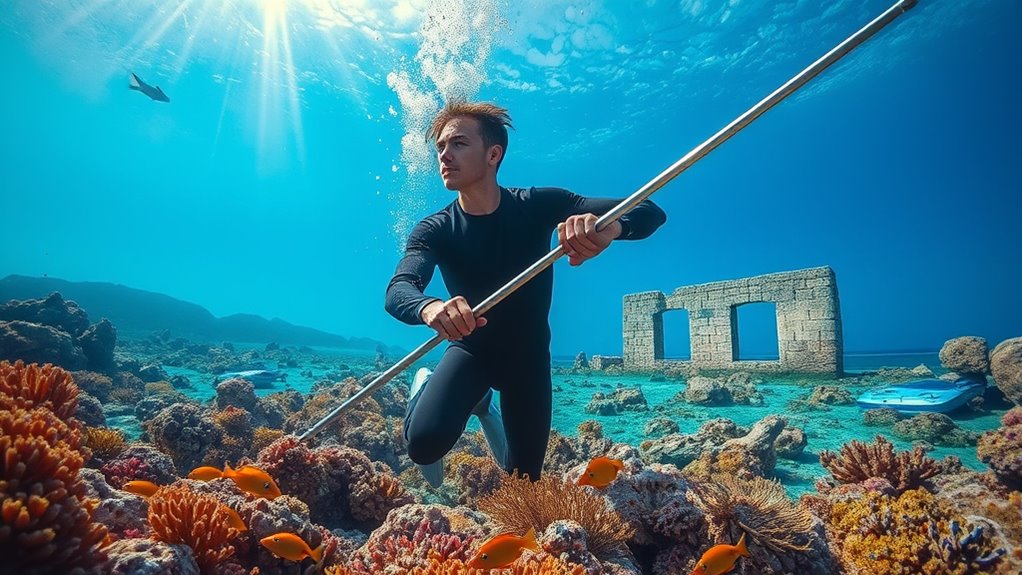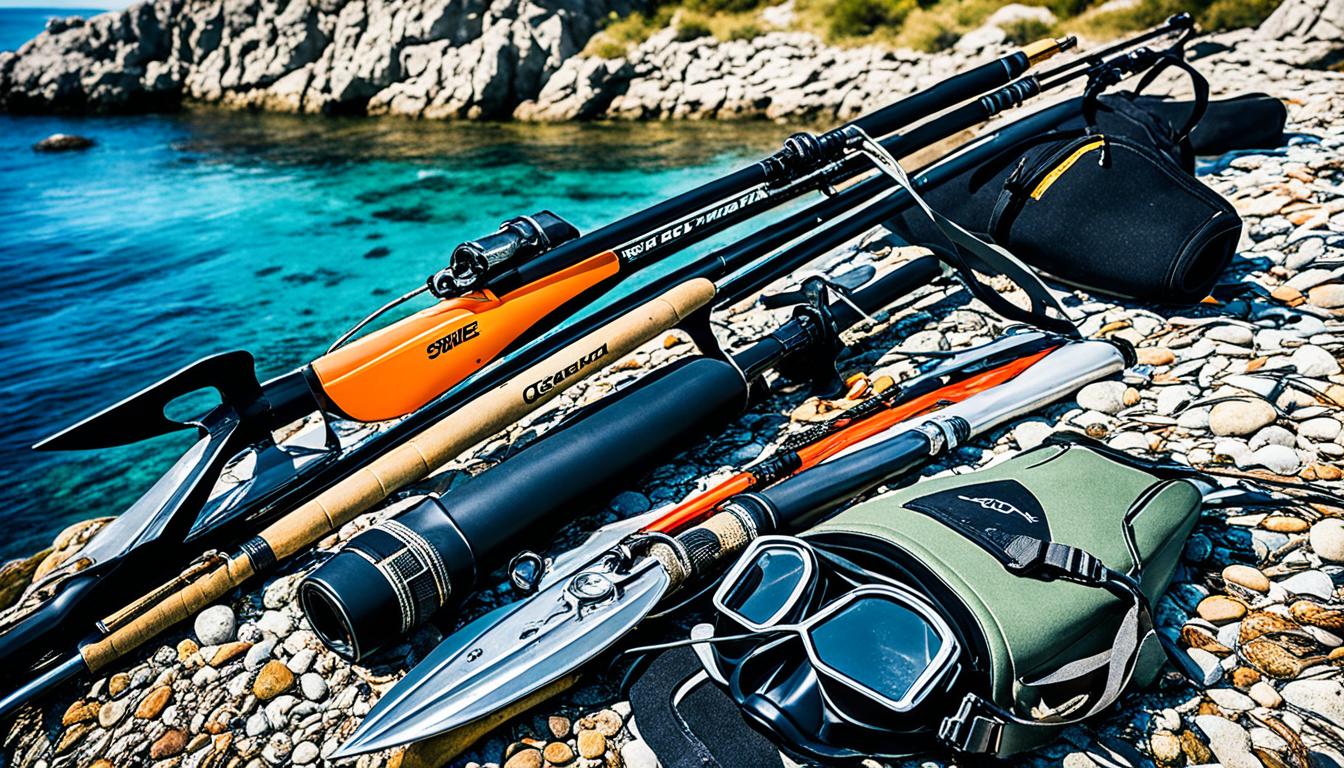The history of spearfishing begins over 16,000 years ago with early humans using bones and wooden sticks to catch fish in rivers and coastal waters. It holds cultural and mythological significance in civilizations like Egypt and Polynesia, evolving from primitive tools to advanced spear guns with modern materials. Over time, techniques and equipment improved, blending tradition with innovation. If you keep exploring, you’ll uncover more fascinating details about this ancient and ongoing practice.
Key Takeaways
- Spearfishing originated over 16,000 years ago with simple tools like bone and wooden spears used by Paleolithic humans.
- Ancient civilizations such as Egypt and Greece depicted spearfishing in art and mythology, highlighting its cultural significance.
- Technological evolution introduced metal-tipped spears, harpoons, and eventually spear guns powered by compressed air.
- Indigenous cultures integrated spiritual rituals, traditional tools, and navigation skills for sustainable and community-based fishing practices.
- Modern spearfishing combines historical techniques with advanced gear like wetsuits, underwater lights, and GPS, evolving into a popular sport.
The Origins of Spearfishing in Ancient Cultures
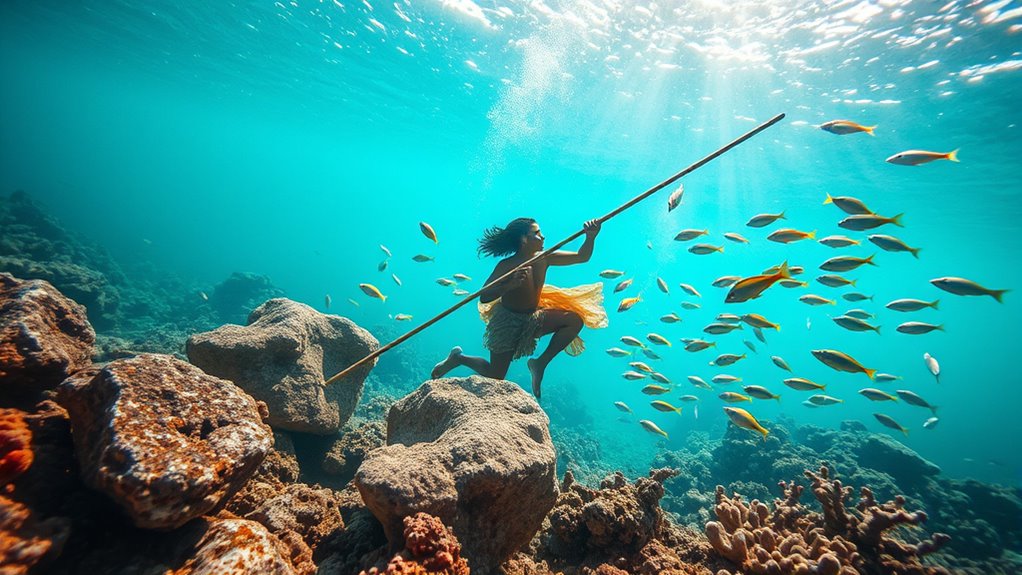
Spearfishing has a history that stretches back at least 16,000 years, with early humans using sharpened sticks and bones to catch fish in rivers, lakes, and coastal waters. Ancient civilizations embraced underwater hunting, developing techniques to improve their catch. Around 3000 BCE, Egyptians depicted fishermen using wooden spears and tridents in hieroglyphics and tomb paintings, showcasing their skill in catching fish. Indigenous peoples like the Tlingit and Haida created multi-pronged spears and trapping methods to sustainably harvest marine life. Later, Greek and Roman writers described the use of barbed and detachable spears, or spear guns, for catching larger fish such as swordfish. These innovations highlight how early civilizations continually refined their tools for more effective underwater hunting.
Early Tools and Techniques in Prehistoric Times
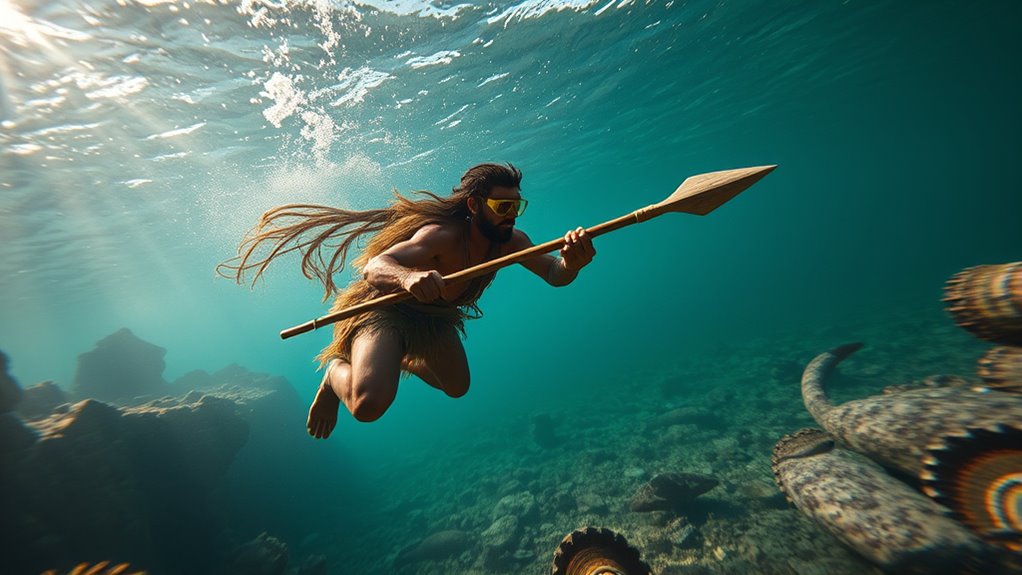
You can see that early humans used simple tools like sharpened sticks, bones, and stones to catch fish. These spears often had barbed tips to hold onto slippery prey, showing clever design. Archaeological evidence reveals that Paleolithic hunters crafted these tools to hunt aquatic animals, shaping the foundation of spearfishing techniques. Additionally, early humans may have experimented with basic underwater tools to improve their hunting efficiency, demonstrating an understanding of primitive underwater technology to enhance their success.
Paleolithic Spear Tools
During the Paleolithic era, humans developed simple yet effective spear tools from available materials like bone, wood, and stone to catch fish and seals. These primitive tools marked early ingenuity in resource gathering. Cave paintings in Cosquer Cave, France, depict scenes of Paleolithic spearfishing, dating back about 16,000 to 25,000 years. Paleolithic spears often featured barbed tips or harpoons to secure slippery prey like fish and seals. They were primarily used in shallow waters and rivers, reflecting limited diving tech. The spears’ design prioritized durability and grip, enabling successful hunting in aquatic environments. These early tools exemplify human innovation in hunting and illustrate the importance of fish and marine life in prehistoric diets. Paleolithic spear tools stand as some of the earliest examples of human craftsmanship. The importance of marine resources highlights how crucial aquatic life was to early human survival and development.
Ancient Fishing Art
Ancient fishing techniques and tools emerged as crucial innovations for prehistoric communities seeking reliable food sources. Early humans used sharpened sticks and bone harpoons to catch fish, especially in shallow waters and along riverbanks. Cave paintings in Cosquer Cave, France, dating around 25,000 years ago, depict scenes of harpooning seals and fish, highlighting the importance of this ancient fishing art. These early tools, including barbed spears made from wood, bone, and stone, were designed to secure slippery aquatic prey. Indigenous groups like the Mincopie of India and Pacific Northwest peoples developed specialized spears and trapping methods for sustainable fishing. Over time, civilizations such as Egypt and Greece adopted wooden spears and tridents, refining their fishing techniques with innovations like detachable, barbed harpoons.
Spearfishing in Ancient Civilizations and Mythology
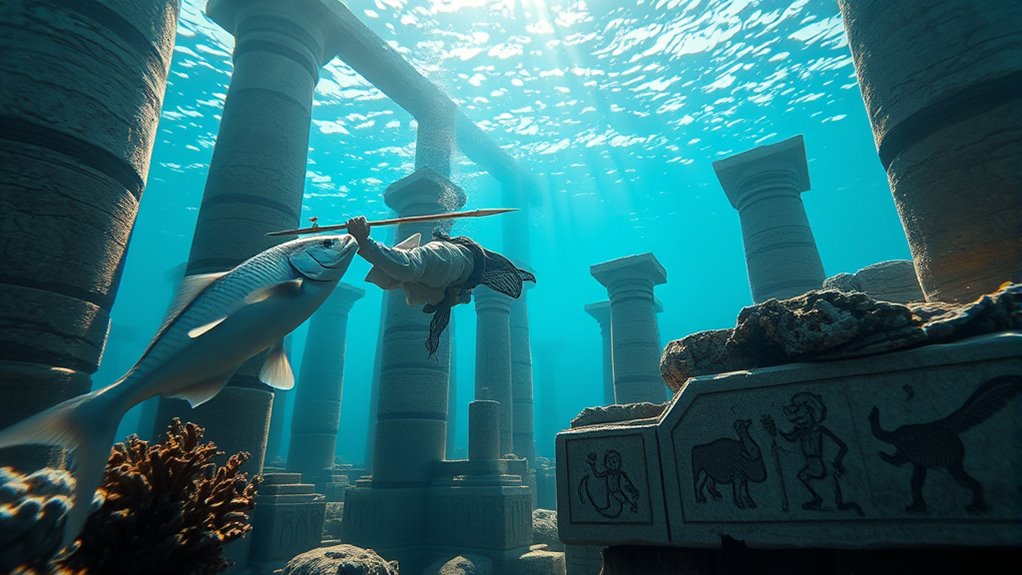
Spearfishing has played a vital role in human history, with evidence spanning from prehistoric times to the ancient civilizations that celebrated it through art and mythology. You can see this in hieroglyphics and tomb art from ancient Egypt (~3000 BCE), showcasing fishermen wielding wooden spears and tridents. Mythology highlights divine mastery, with figures like Poseidon and Maui wielding spears or fishhooks, symbolizing control over the sea. Polynesian cultures developed sophisticated spear and canoe systems, blending spiritual rituals with underwater fishing mastery. Cave paintings in Cosquer Cave (France), dating back around 25,000 years, depict harpooned seals, emphasizing spearfishing’s deep roots. These civilizations and myths reveal how spearfishing was not just survival but a cultural and divine act, shaping human connection to the ocean. The integration of automation technologies in modern fishing methods continues this long tradition of innovation and mastery over aquatic resources. Additionally, advancements in fishing equipment have improved efficiency and safety for contemporary spearfishers. Furthermore, the development of specialized training techniques has enabled practitioners to refine their skills and adapt to various underwater environments.
The Role of Spearfishing in Polynesian Voyages and Traditions
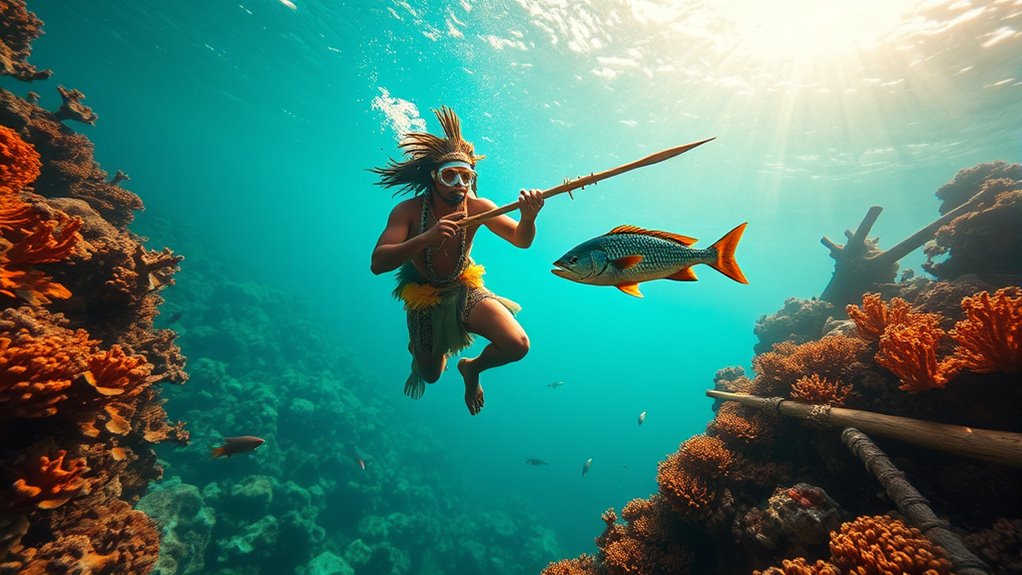
You see how Polynesians used expert navigation skills to reach remote fishing grounds, turning spearfishing into a crucial part of their voyages. Their fishing techniques and tools were deeply rooted in cultural traditions, often accompanied by rituals honoring the sea gods. Spearfishing wasn’t just about catching food; it symbolized bravery, respect for nature, and reinforced community bonds. Additionally, the cultural impact of traditional practices continues to influence modern perceptions of artistic expression related to seafaring and community rituals. The development of specialized fishing gear, such as crafted spears and harpoons, further exemplifies their ingenuity and cultural significance. Incorporating traditional techniques into modern practices helps preserve these cultural identities and highlights the artistry involved in their creation. Furthermore, the tradition of spearfishing remains a vital aspect of cultural heritage, emphasizing the importance of cultural preservation in contemporary times. The craftsmanship of spearfishing equipment often reflects intricate artistic design, showcasing the creativity and skill of Polynesian artisans.
Polynesian Navigation Skills
Polynesian navigators combined their mastery of celestial cues, ocean currents, and wind patterns to traverse vast stretches of the Pacific Ocean, relying heavily on spearfishing as an essential food source during these voyages. They used traditional tools like handheld spears, Hawaiian slings, and outrigger canoes, showcasing their expertise in underwater hunting and navigation. Their deep knowledge of maritime culture enabled them to:
- Read star positions for direction
- Track wave and current patterns
- Use ocean swells as guides
- Recognize wind shifts for course adjustments
- Locate productive fishing grounds
This sophisticated navigation allowed them to explore, settle distant islands, and sustain their maritime lifestyle. Spearfishing techniques weren’t just survival; it was integral to their exploration, spiritual practices, and cultural identity. Their refined understanding of marine environments was crucial in identifying productive fishing grounds, ensuring sustainability and success in their hunts. Additionally, their ability to interpret cost behavior analysis helped optimize their resource management, supporting long voyages and community resilience. Moreover, their ability to read oceanic signs further enhanced their navigation skills, enabling successful long-distance voyages and resource acquisition.
Cultural Significance of Spearfishing
Throughout Polynesian culture, spearfishing was more than just a means of sustenance; it embodied spiritual beliefs and social identity. It was woven into maritime traditions, with rituals honoring the sea and marine life, reflecting respect and spiritual connection. Oral folklore celebrates fishermen’s skill and bravery, emphasizing the cultural importance of spearfishing. These practices were passed down through generations, shaping cultural identity and survival. Long ocean voyages relied on spearfishing, demonstrating their sophisticated understanding of marine environments. Additionally, the tradition of spearfishing played a vital role in establishing social hierarchy and community cohesion among Polynesian peoples. The vetted techniques and tools used in spearfishing exemplify their deep connection to the water and nature. Furthermore, the integration of cultural heritage into spearfishing practices highlights its significance beyond mere subsistence, reinforcing communal bonds and spiritual beliefs. Recognizing the importance of Indigenous knowledge in these practices helps preserve their cultural significance and sustainability.
Evolution of Spearfishing Equipment Through the Ages
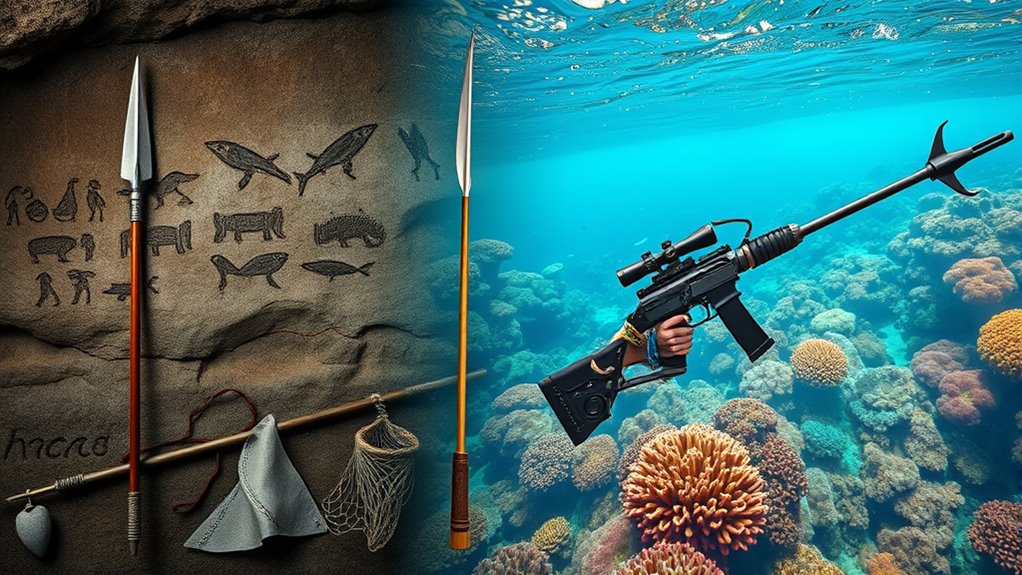
The evolution of spearfishing equipment reflects a continuous quest for greater efficiency, safety, and maneuverability beneath the waves. Early tools, over 16,000 years old, were simple sharpened sticks and bone harpoons. As civilizations like Egypt and Greece advanced, metal-tipped spears made from bronze and iron boosted durability and effectiveness. In the 20th century, spear guns powered by elastic cords, compressed gas, or CO2 transformed underwater hunting, offering longer range and more power. Modern gear now includes:
- Carbon fiber fins for agility
- Stainless steel knives for safety
- High-visibility buoy systems for safety
- Integrated mask and snorkel designs
- Quick-release weight belts for comfort
Advancements in materials like carbon fiber and stainless steel have significantly enhanced the durability and performance of spearfishing gear. Additionally, the development of specialized spearguns with ergonomic grips and adjustable mechanisms has improved user control and targeting accuracy. Modern innovations also incorporate sustainable materials, reflecting a growing concern for environmental impact and resource conservation. These innovations continually improve your spearfishing experience, blending tradition with modern technology.
Historical Accounts and Artistic Depictions of Spearfishing
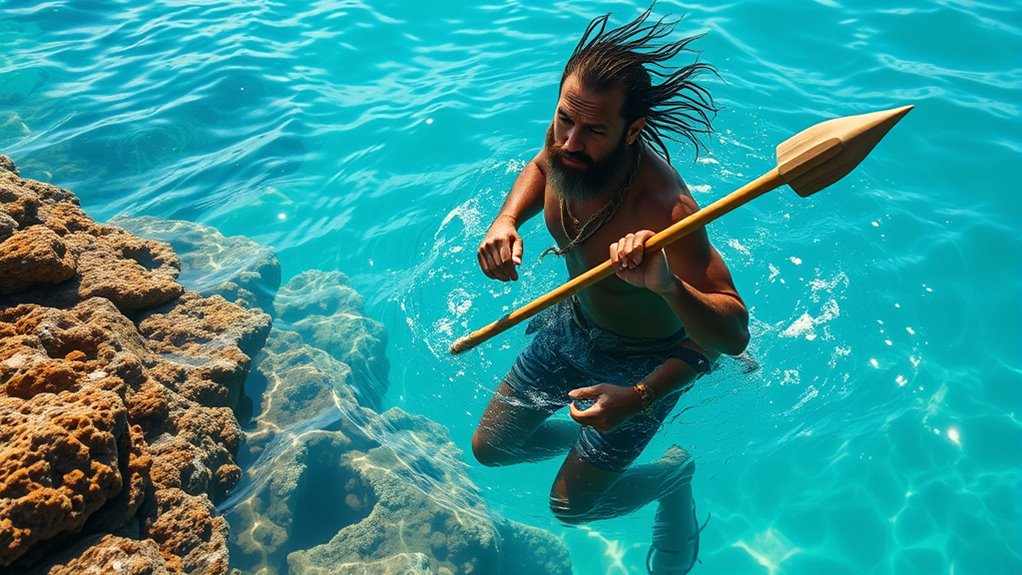
Have you ever wondered how ancient people recorded their encounters with the sea? Artwork and artifacts reveal their stories through depictions of spearfishing. Cave paintings in Cosquer Cave, France, dating back around 16,000 years, vividly show scenes of hunters spearing seals, offering a glimpse of early aquatic pursuits. Ancient literature also references spearfishing; the Bible’s Job 41:7 mentions fishing spears in the context of Leviathan, highlighting their significance. Greek historian Polybius describes the use of barbed, detachable spears for swordfish hunting in the Mediterranean, while Oppian’s “Halieutika” details various spear types, including tridents. Artworks from Egypt and the Indus Valley further depict fishermen wielding sharpened sticks, harpoons, and multi-pronged weapons, illustrating the long history of spearfishing across civilizations.
The Rise of Sport Spearfishing in the 20th Century
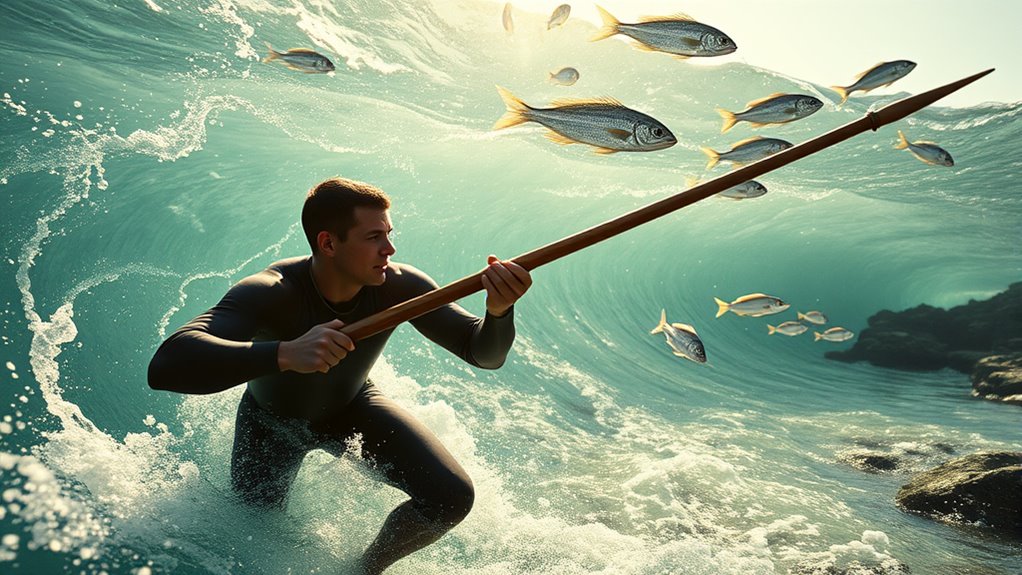
As civilizations documented their early encounters with the sea through art and stories, the fascination with underwater hunting grew beyond survival needs to become a recreational pursuit. In the 1920s, sport spearfishing gained popularity along the Mediterranean coast, driven by improvements in diving gear and spear technology. The invention of spear guns, especially those powered by compressed air, expanded your range and effectiveness.
Early 20th-century spearfishing evolved into a popular recreational sport with advances in gear and technology.
- Enhanced diving gear like wetsuits and fins allowed longer dives
- Compressed air powered spearguns increased reach
- Underwater hunting became more accessible and competitive
- Organized competitions and record hunts emerged
- Spearfishing technology continued evolving, attracting enthusiasts worldwide
This evolution transformed spearfishing into a dynamic sport, blending skill, equipment, and adventure, and setting the stage for modern underwater hunting pursuits.
Modern Innovations and Technological Advances in Spearfishing
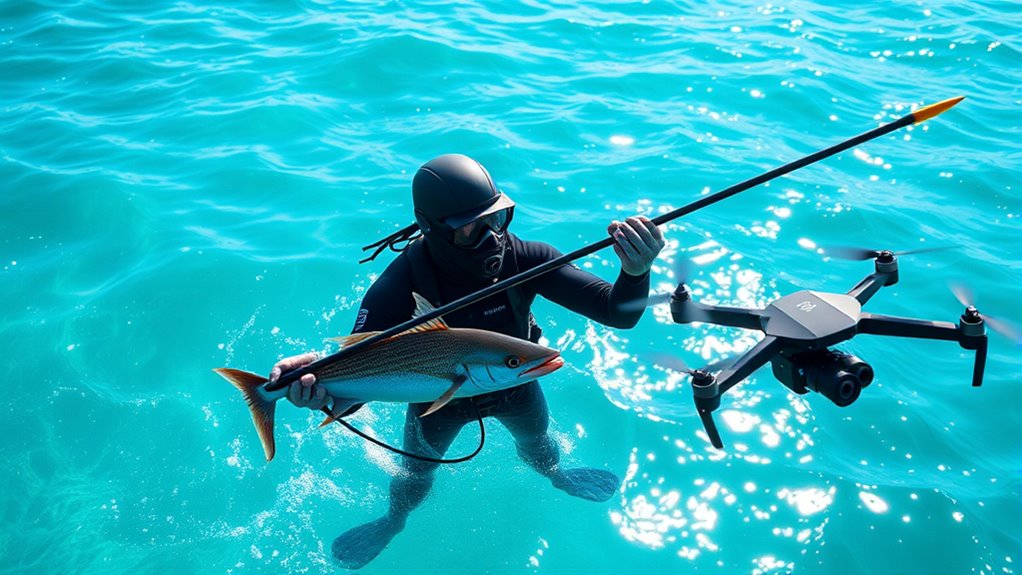
Modern innovations and technological advances have transformed spearfishing into a highly precise and efficient sport. New spearguns, like spring-propelled models from the 1930s and CO2-powered guns from 1956, have dramatically increased range and accuracy. Improvements in diving equipment, including high-quality masks, fins, wetsuits, and snorkels, boost divers’ mobility and endurance underwater. The addition of spear gun line reels and adjustable trigger mechanisms has made fish retrieval smoother and more effective. Advanced materials such as carbon fiber, fiberglass, and lightweight plastics have lowered gear weight while boosting durability. Modern technology, like underwater LED lights and GPS or depth trackers, allows for better navigation and targeting in challenging conditions, elevating the precision and overall performance of spearfishing.
Conservation, Sustainability, and the Cultural Significance of Spearfishing

Spearfishing holds deep cultural significance for many indigenous communities, serving as both an essential tradition and a means of connecting with their environment. It embodies traditional knowledge passed down through generations, fostering respect for marine ecosystems. Modern practices focus on sustainable practices to prevent overfishing and protect vulnerable species. Regulations and bans recognize the cultural importance of spearfishing for indigenous groups while promoting marine conservation. This balance helps preserve cultural traditions and ensure ecological health.
- Upholding traditional knowledge through practices
- Supporting marine conservation efforts
- Respecting cultural significance in regulations
- Emphasizing sustainable practices
- Fostering a connection between communities and the sea
Frequently Asked Questions
Why Is Spearfishing Illegal?
You might wonder why spearfishing is illegal in many areas. It’s mainly to protect fish populations, especially endangered species, and prevent overfishing. Regulations also aim to conserve reef ecosystems and reduce habitat damage caused by certain methods. When you break these laws, you risk hefty fines, equipment confiscation, and legal trouble. These restrictions help ensure sustainable fishing and safeguard marine biodiversity for future generations.
What Is the History of the Spear Weapon?
Imagine a timeless spear, whispering tales of ancient hunts, piercing through centuries of human ingenuity. You see, the spear’s history stretches back 16,000 years, crafted from bone, wood, and stone. As civilizations evolved, so did the weapon—metal tips, multi-pronged designs, and modern spear guns propelled by gas or elastic power. You hold a link to humanity’s primal quest to connect with nature through this ancient, enduring tool.
What Are Some Interesting Facts About Spearfishing?
You might find it fascinating that spearfishing is one of the oldest fishing methods, dating back over 16,000 years. Modern techniques use advanced gear like spearguns and freediving equipment, making it more efficient and safe. It’s also environmentally friendly because it’s selective and doesn’t involve bait or by-catch. Plus, ancient civilizations like Egypt and Polynesia developed sophisticated tools, showing how this practice has evolved over millennia.
Did Native Americans Spear Fish?
Yes, Native Americans did spear fish. You can see evidence in archaeological finds of wooden, bone, and stone spears and harpoons used in rivers, lakes, and coastal waters. They developed sophisticated techniques, like multi-pronged spears and fishing traps, to increase their catch. Their art and stories also highlight spearfishing’s importance for food, cultural traditions, and spiritual practices, making it an essential part of their way of life.
Conclusion
As you explore spearfishing’s rich history, you’ll see how this ancient practice has evolved into a modern sport embraced worldwide. Did you know that in 2020, an estimated 3 million people participated in spearfishing globally? This shows its enduring appeal and cultural significance. Whether for tradition, sport, or conservation, spearfishing continues to connect you with nature and history, reminding you of its deep roots and evolving innovations.

